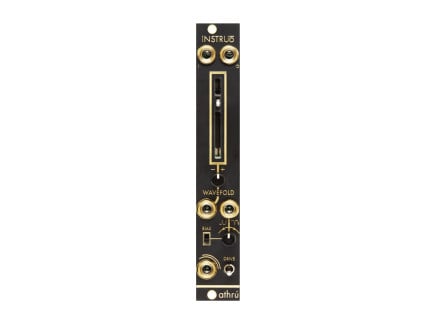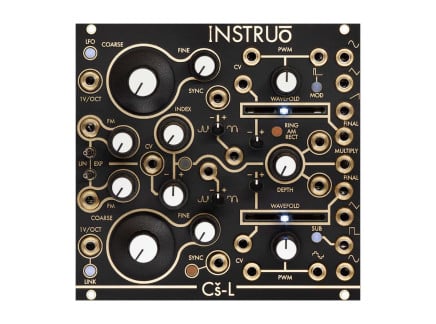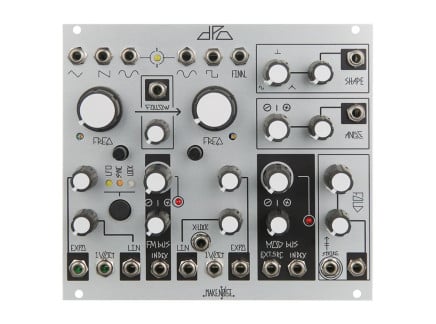In the world of modular synthesis, sometimes it can feel like the types of sounds you can make are limited by the gear that you have. And when in that mindset, it can start to feel like your creative ideas have to be put on hold until you have something that you don't already own. We all succumb to this from time to time, and for me, it feels absolutely exhausting—but the truth is, you can make a remarkable breadth of sounds with even a very modest modular setup.
In our recent live stream, Rich Timbres with Simple Eurorack Modules, our very own Trevor walks us through some of the foundational concepts of synthesis. This stream should be particularly useful to folks new to modular synthesis, as well as experienced users who want to find new tricks or see an alternate perspective on classic synthesis techniques. So if you're looking for patch tips and tricks, check it out!
Here, let's take a look at some of the topics Trevor discusses in his presentation, and talk about how they relate to a typical synth workflow.
The Classic Monosynth Patch
Most synthesizers operate based on a group of simple techniques called subtractive synthesis. Subtractive synthesis largely relies on using a small number of raw sound sources (oscillators) and using a filter to remove harmonics. But what does that mean? Understanding oscillators themselves is important: these give our sound their overall character, and are the way that we define pitch. Oscillators usually have different outputs for different wave shapes, and each wave shape in turn has its own distinct tone color (or timbre) based on its harmonic makeup. Sine waves are clean and pure, with no significant overtones; saw waves, on the other end of the spectrum, have a very full harmonic makeup and therefore sound buzzy and bright. (For more detail about the sound of the typical synthesizer wave shapes, check out this article.)
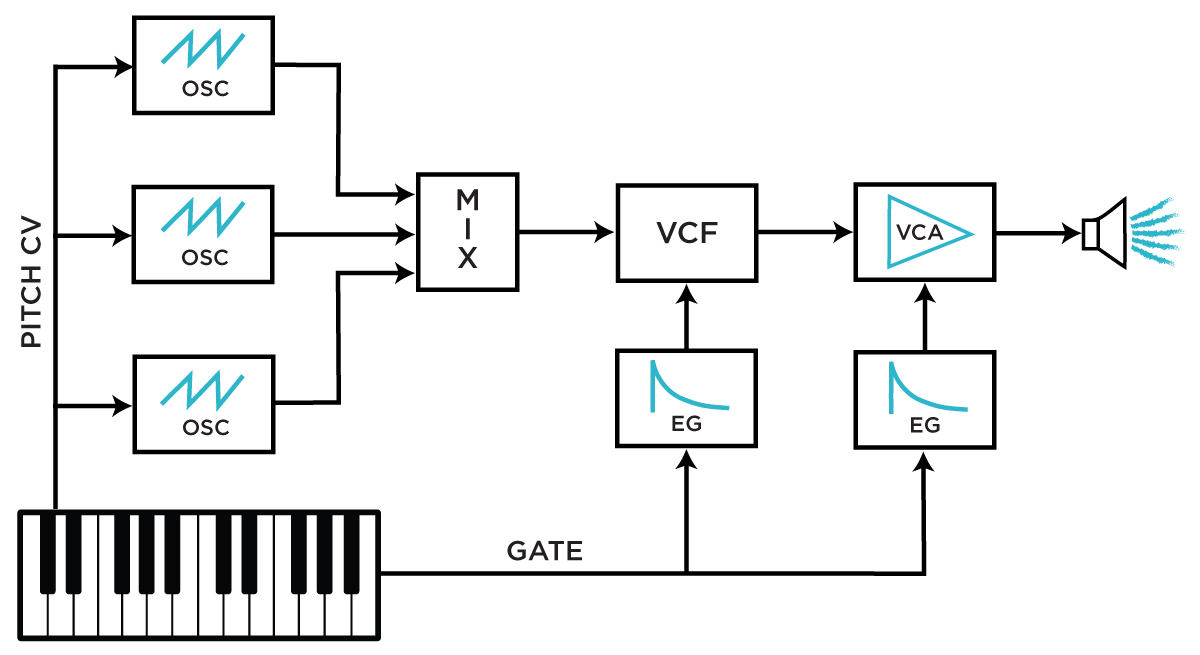
In most classic synthesizers, an oscillator or group of oscillators is sent into a filter, as in the diagram above. The filter takes the raw, coarse sound of the oscillators and shapes the loudness of their overtones. A lowpass filter, for instance, removes high harmonics and allows only lower tones to pass, making sounds darker than the raw waveform itself. A highpass filter, on the other hand, removes the low parts of a sound and only leaves the fizzy, buzzing high end. Filters usually feature adjustable cutoff frequency, so you can adjust just how intense the filtering effect actually is—and the character of every filter is unique. (To learn more about different types of filters and how to use them, check out our article Learning Synthesis: Filters.)
Even just one oscillator running into a filter can sound awesome and huge: but things change considerably when you have multiple oscillators. By mixing together multiple oscillators, you sum their shapes together, creating much more complex shapes than the basic sines, saws, and squares we're used to. If you mix together two oscillators of different shapes and tune them to exactly the same pitch, they will generate a static combined shape—but by detuning them slightly, they will slip in and out of phase with one another and create shapes that constantly shimmer and change. The amount of detuning will impact the perceived speed of timbral change: this technique is called heterodyning, and the rate at which the timbre seems to shift is called a beat frequency. The more detuning, the faster the beat frequency. This is part of what makes the sound of multi-oscillator synths like the Minimoog so cool: it's almost impossible to keep the oscillators exactly in tune with one another, so they constantly produce this lively detuning effect. And of course, by tuning the oscillators to intervals other than unisons, you can achieve even more interesting shapes: try tuning them to octaves, fifths, and other intervals to create rich towers of sound.
Even just using a couple oscillators and a filter can lead to excellent tones—and most monosynths out there will allow you to do this directly. However, if you have access to the raw components of synthesis (as you do in a modular system), you can start to explore more advanced techniques than many keyboard synths will allow. So let's take a look at some more techniques for animating a sound's timbre.
Basic Modulation Tactics: PWM & Sync
Many oscillators (in keyboard and modular synths alike) feature options for PWM and Sync. These classic techniques have been available in synths from the original Moog Modular systems onward, and have defined countless classic synth tones.
PWM, or Pulse Width Modulation, is a special means of modulating the shape of an oscillator's square wave output to create different types of timbres. In short, it allows you to modify the square wave's overall width: the balance of the square that is high and low. This has a profound impact on the timbre, creating everything from very full to very nasal effects. And best of all, if you automate changes to the pulse width using an envelope or LFO, you can mimic the sound of having several oscillators slightly detuned...and as such, PWM is a go-to technique for making huge, swarmy bass lines without needing a huge number of modules: just an oscillator, filter, and LFO can go a long way.
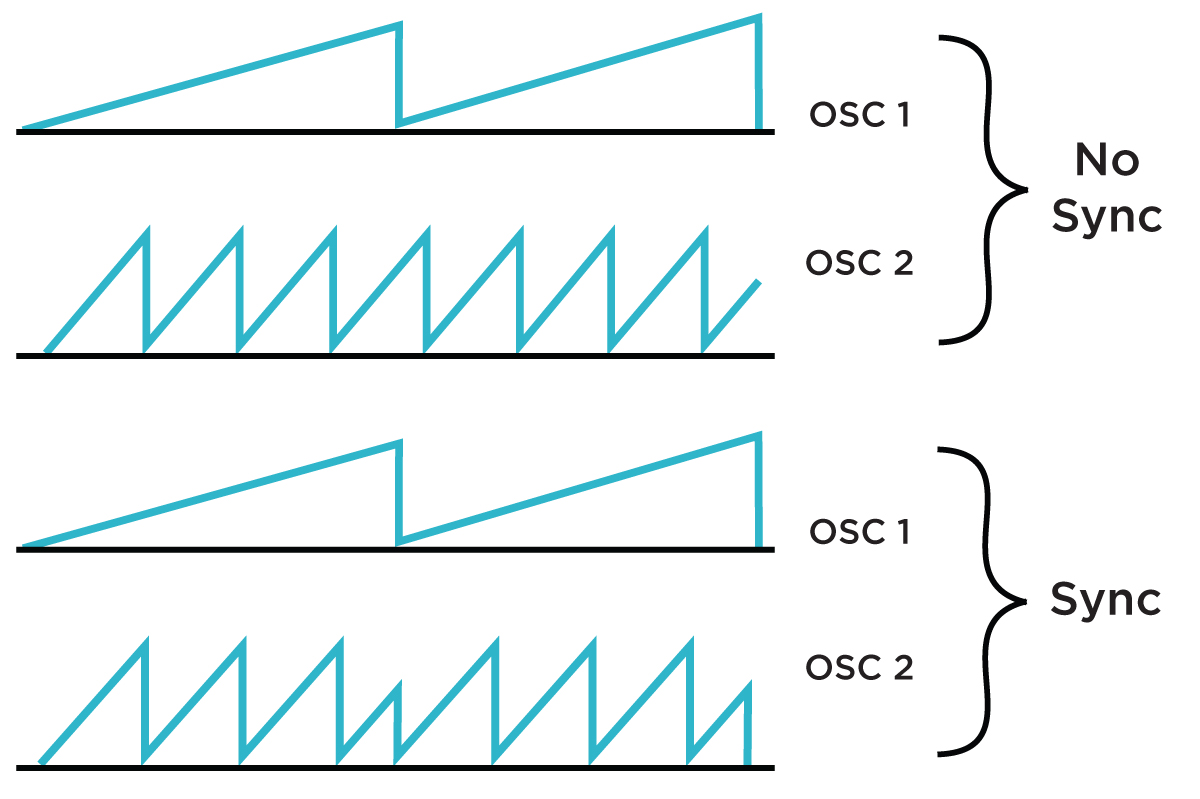 Visual sync demonstration with two saw oscillators
Visual sync demonstration with two saw oscillators
Sync is another classic tone-shaping method that allows you to change a sound's timbre. Sync is its own can of worms which could be discussed at great depth, but the most common usage is called hard sync. In hard sync, there are typically two oscillators: a modulator and a carrier (which can be thought of as a master and slave). Usually, a hard-edged waveform like a square wave is taken out of the master oscillator and patched into the Sync Input on the slave oscillator. This forces the slave oscillator's shape to reset with each cycle of the master oscillator—and when the master oscillator is higher in pitch than the slave, this creates a pitch tracking effect that keeps both oscillators in tune with one another (while affecting the timbre of the slave).
However, if your modulator is lower in pitch than the carrier, this can have a very peculiar impact on the timbre, creating almost metallic-sounding resonances. By continuously varying the pitch of the modulator with an envelope or LFO, you can create bizarre sweeping sounds that instantly evoke the synth leads of the 1980s.
PWM and Sync are relatively common options in keyboard synths, though they can be explored more freely in the context of modular synthesis. There are still other techniques far less common in keyboards that can be a great way of exploring the unique potential of modular synths.
West Coast Tone Colors: Wave Folding
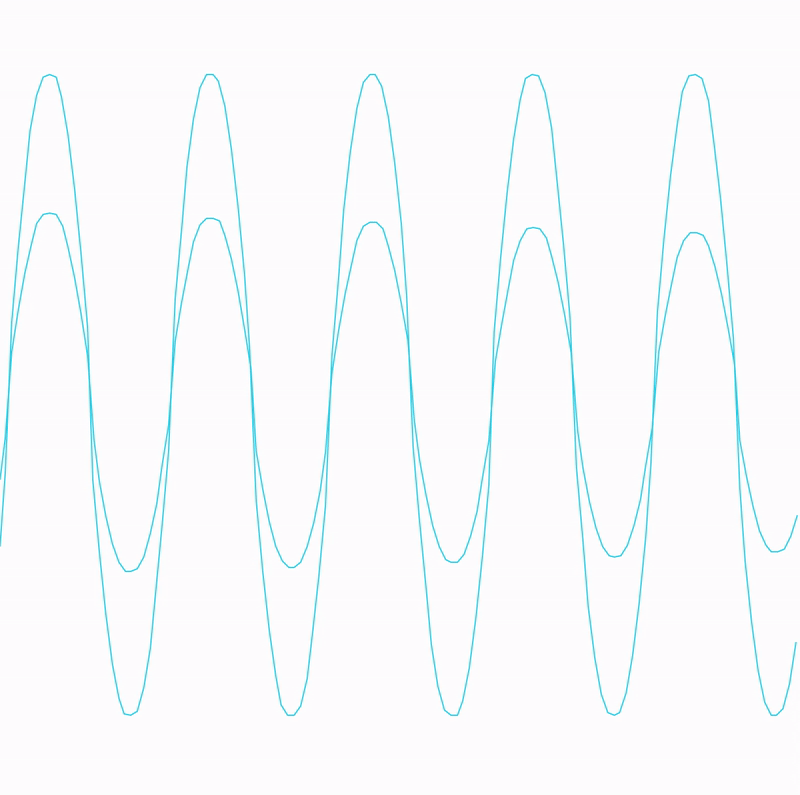 Simple folding of a sine wave
Simple folding of a sine wave
Relatively uncommon in keyboard synths, wave folders allow you to take contoured shapes like triangle and sine waves and change them considerably. Like Sync, wave folders and wave shapers are their own huge topic—they can achieve their effects in vastly different ways from one another. We dive deeper into the topic in this article, but in short, wave folders can be used to directly alter the shape of a wave in order to introduce harmonics not present in the original signal.
This differs significantly from the common approach of starting out with a harmonically rich waveform like a saw wave and filtering out harmonics to create an interesting sound. Instead, we start with softer sounds like sines and triangles and wind up with far more complex tones after the process. It's a vastly different way of thinking about sound design (one borrowed from the Buchla / "West Coast" school of synthesis), and one that can be combined with filtering and more traditional sonic techniques to excellent effect.
Amplitude Modulation Effects: AM & RM
Different types of modulation can be a great way to alter the character of a sound. Up to this point we've primarily discussed techniques that maintain a sense of distinct pitch: for the most part, the pitch of an oscillator going into a wave folder, for instance, will be the same pitch that you perceive coming out of the wave folder. With more extreme modulation effects, however, this isn't always the case.
 Basic AM setup with two oscillators and a VCA
Basic AM setup with two oscillators and a VCA
Amplitude modulation, or AM, involves using one oscillator to modulate the loudness of another. This is typically achieved by patching one oscillator to a VCA's audio input and another into the VCA's CV input. This effect generates audio sidebands: sort of phantom frequencies that emerge as a result of the modulation. Without careful tuning of the two oscillators, the sidebands will appear at pitches not harmonically related to the two oscillators themselves...and as such, AM often results in clangorous, inharmonic sounds.
Ring modulation (sometimes abbreviated as RM) is very similar in tone to AM, though often even more clangorous due to its typically more accentuated sidebands. Ring modulation cannot be achieved with a VCA alone, and often requires a dedicated ring mod module...though luckily, these are fairly plentiful and affordable. Ring modulation is famous for generating robotic sounds when performed with a voice and an oscillator, or for quasi-radio tuning sounds when using two oscillators. However, both this technique and AM can be fine tuned to produce quite musical results.
If you tune the carrier and modulation oscillators to harmonically-related intervals, AM and RM can produce rich, stable timbres. By tuning the two oscillators an octave or fifth apart, for instance, you generate sidebands that reinforce the sound's natural harmonic structure: and as a result, create interesting waveforms difficult to achieve otherwise. Try locking in a solid AM or RM sound with two oscillators and then send them both the same sequence: you'll maintain your tuning ratio and the timbre will remain stable. Alternatively, try tuning both oscillators to the root note of the song you're working on and then RM or AM them, but send the sequence to only one: you'll create a huge variety of sounds that create a sort of "timbre melody" of their own. "Perfect" intervals like fourths, fifths, and octaves will produce relatively stable sounds, while other intervals will create crunchier, more distorted timbres.
Pitch Modulation Effects: FM
And then, of course, there's FM—frequency modulation. As with many of the other techniques we've discussed, there is a whole rich world of technique that comes along with FM, complete with complex terminology and theory. Luckily, in the analog world the rules of FM are pretty simple: in short, if you plug an oscillator into another oscillator's FM input, it's going to sound cool. Of course, there's more to it than that—but intuition can play a strong role in getting analog FM to suit your own purposes.
FM, like AM and RM, introduces sideband frequencies not present in the original signal. Unlike AM and RM, though, FM directly affects the behavior of the oscillator itself—and with analog oscillators, this typically means that a significant amount of pitch drift is generated. Different types of FM can manage pitch drift better than others (for instance, linear FM typically preserves pitch better than exponential FM), however analog FM nearly always results in some pitch deviation—so dialing in predictable, stable pitches can be a bit difficult.
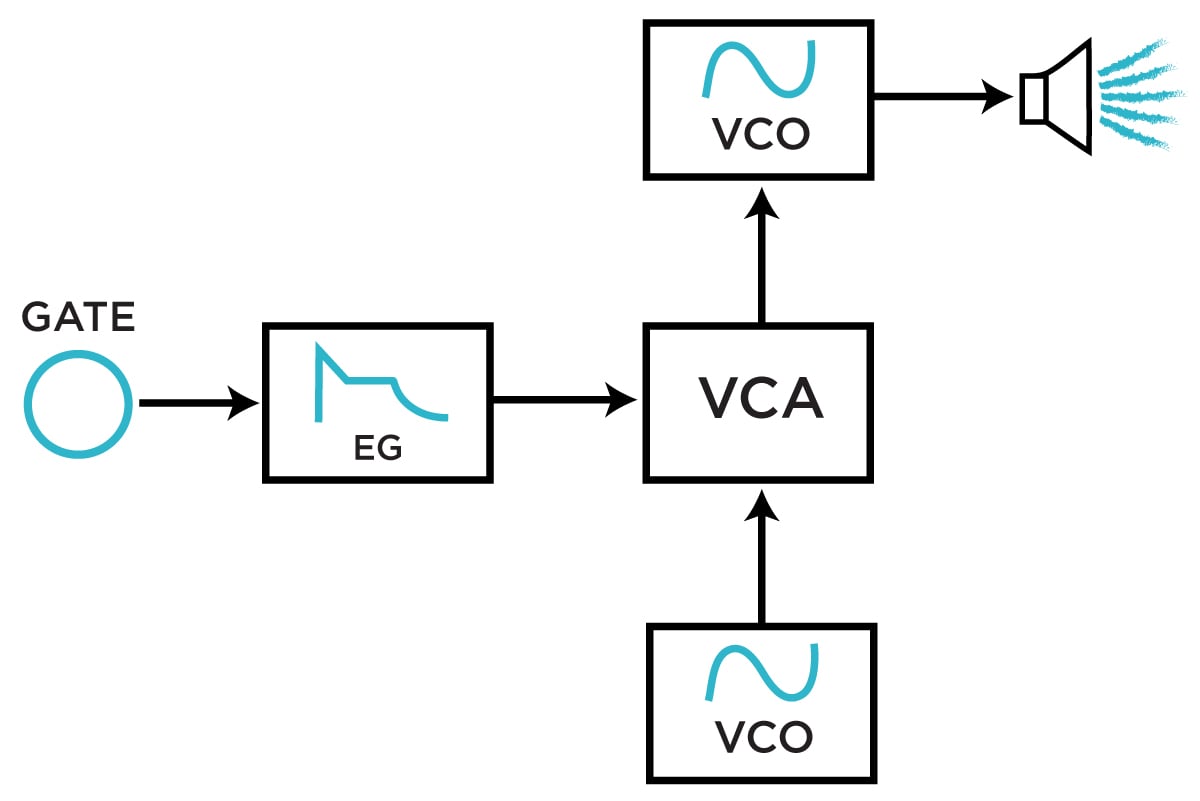 Using a VCA as an FM depth control between two oscillators
Using a VCA as an FM depth control between two oscillators
One interesting FM trick is to run the modulation oscillator first through a VCA before sending it into the carrier oscillator's FM input. If you do this, you can use an envelope to vary the FM amount. By creating plucky, short envelopes, you can use this to add a percussive attack to an otherwise stable tone—or you can use it to create FM swells that evolve as the note sustains.
Trevor also introduces cross modulation in his presentation: a method in which two oscillators are allowed to frequency modulate one another. This results in quite chaotic sounds, from noisy bursts to screeches and howls. This is great for lovers of noise; however, it's a bit difficult to use in melodic contexts. It can make an excellent source of percussive sounds, however—so if you're looking for a way to cook up some bizarre, lively snare or hat sounds, this could be a good technique to explore.
Of course, there are plenty of dual oscillator modules out there designed to take advantage of FM, from Make Noise's DPO to the Verbos Complex Oscillator; but you can take advantage of these techniques with almost any oscillators—as long as you have two oscillators with pitch CV or FM inputs, these techniques are completely available to you.
The world of synthesis is, of course, quite vast—these are but a few of the countless techniques for working with sound. Luckily, all of these tricks can be explored with even a modest set of Eurorack modules. Hopefully this has offered some inspiration about how to make use of what you already have...or perhaps has helped to show you how to get started!
Until next time, keep exploring...





